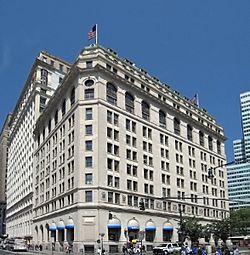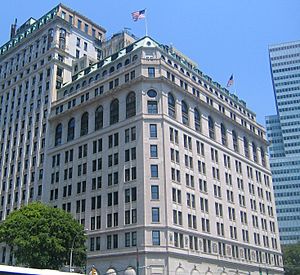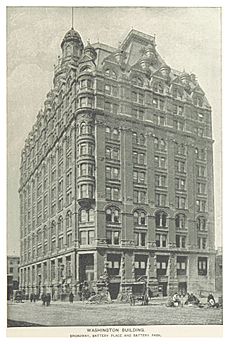International Mercantile Marine Company Building facts for kids
|
International Mercantile Marine Company Building
|
|
|
U.S. Historic district
Contributing property |
|

(2010)
|
|
| Location | 1 Broadway, New York City |
|---|---|
| Area | less than one acre |
| Built | 1919 |
| Architect | Chambers, Walter B. |
| Architectural style | Classical Revival |
| Part of | Wall Street Historic District (ID07000063) |
| NRHP reference No. | 91000108 |
Quick facts for kids Significant dates |
|
| Added to NRHP | March 2, 1991 |
The International Mercantile Marine Company Building (also known as 1 Broadway or the United States Lines Building) is a tall office building in the Financial District of Manhattan, New York City. It stands at the corner of Battery Place and Broadway. It is right next to Bowling Green park on the east and the Battery park on the south.
This building was first built in 1882. It was called the Washington Building and had a Queen Anne style. In 1919, a big shipping company called the International Mercantile Marine Company (IMM) bought it. They changed it a lot to look like the Neoclassical style you see today.
The building was the main office for IMM and its later company, United States Lines, until 1979. After that, it continued to be used for offices and a bank. It was added to the list of National Register of Historic Places (NRHP) in 1991. In 1995, it became a city landmark. It is also part of the Wall Street Historic District, which is another historic area.
Contents
What Does the Building Look Like?
The International Mercantile Marine Company Building is surrounded by streets and parks. It faces Battery Place and the Battery to the south. Broadway and Bowling Green are to the east. Greenwich Street is to the west, and the Bowling Green Offices Building is to the north.
The building has different addresses, including 1 Battery Place and 1-3 Greenwich Street. It has a long side facing Battery Place (about 171 feet). It also has sides facing Greenwich Street (104 feet) and Broadway (100 feet). From the building, you can see the New York Harbor to the south. There are also subway entrances for the New York City Subway's Bowling Green station right outside.
The building was first designed by Edward H. Kendall in the Queen Anne style. Later, Walter B. Chambers designed its current Neoclassical look.
How Tall is the Building?
1 Broadway is a 12-story building. The first floor is very tall, so sometimes it's counted as two floors. When it was first built, it was 9 or 10 stories high. Later, it was made taller to 14 stories, including a special roof called a mansard roof.
The mansard roof is still there and is like the 13th story. An attic above that roof is like the 14th story. The building has a slight U-shape. This shape creates a small open space on the north side. This space connects to a larger open area of the building next door, 11 Broadway.
What is the Outside Made Of?
The building has special entrances on the sides facing Battery Park. These entrances used to be marked "First Class" and "Cabin Class" for ship passengers. The outside of the building, from the first to the 12th floor, is made of light brown Indiana Limestone. This stone replaced the original red brick and sandstone.
The panels between the windows are made of green marble. The bottom part of the building, called the water table, is made of granite. The two corners of the building that face Battery Park are cut at an angle, called "chamfered." These corners have entrance doors at the bottom.
The windows on the ground floor are tall and arched. They have many small glass panes. Above them are half-domed awnings. On the Broadway side, there are five sections, called "bays." The middle bay on the ground floor has the main entrance archway. It has carvings of Mercury (the god of travel) and Neptune (the god of the sea). Above this, there is a triangle-shaped top, called a pediment, with an eagle carving.
The two bays to the north on Broadway are simpler entrance archways. The bays to the south are window openings. On Battery Place, there are nine bays. The second-to-last bays on each side have entrances. The eastern one was for first-class passengers, and the western one was for cabin-class passengers. On Greenwich Street, there are six bays. Most are tall windows, but the northernmost bay has doors and stairs to the elevators. You can also see basement windows at the very bottom. Stairs used to lead to a third-class passenger entrance in the basement.
There's a decorative band, called an entablature, between the first and second floors. On the second floor, between the windows, you can see mosaic shields. These shields show symbols of famous port cities. From the third to the seventh floors, each bay has two windows. The panels above these windows are made of yellow marble. The panels above the fourth floor also have round decorations. The angled corners of the building have one window on each floor.
The 8th and 9th floors look like an arcade with one arched window in each bay. The 10th floor has two windows in each bay. On the angled corners, the 8th and 10th floors have rectangular windows. The 9th floor on these corners has a round window, called a rose window. The 11th and 12th stories are part of the copper mansard roof. The 11th floor is set back a bit and has a railing, called a balustrade. Above the roof are three small towers that hold building equipment.
The Booking Room
The main booking room on the first floor is very long (about 160 feet) and wide (about 40 feet). It runs along Battery Place and has a high ceiling (25 feet). Its floor was originally marble, but it was later covered. Inside, there was a large compass design on the floor. Two huge paintings showed shipping routes across the oceans.
This former booking room was designed to look like a fancy ballroom from the 1700s. It had columns and decorative railings. There were also four large chandeliers and marble walls. This space is now a Citibank branch. To the north of this room is the building's original lobby. It also has marble floors and walls. The lobby leads to the elevators and an emergency staircase.
History of 1 Broadway
Early Days of the Site
In the 1600s, two taverns (like inns or pubs) were on the land where 1 Broadway now stands. One was called "Knocks Tavern," built around 1649. This was probably the first permanent building there.
In 1745, a British Navy captain named Archibald Kennedy bought the land. Around 1760 or 1768, Kennedy built a grand house there. It was a two-story mansion with materials brought from the Netherlands. It had a long living room and connected to the house next door.
Kennedy lived there until 1776, during the American Revolutionary War. He then left for New Jersey. The Kennedy house was briefly used as headquarters for American generals like Henry Lee III and Israel Putnam. It might even have been used by General George Washington himself, as well as by high-ranking British generals.
After the war, the house was fixed up. Then, a banker named Nathaniel Prime lived there for many years. In 1854, the building became the Washington Hotel. An old drawing from 1859 shows the hotel as being four stories tall.
The Washington Building is Built
In 1881, Cyrus West Field bought the Washington Hotel and the house next to it for a lot of money. The hotel's furniture was sold. In November 1881, Field announced a contest for architects. He wanted them to design a new commercial building, the Washington Building, on the hotel's site.
Edward H. Kendall won the contest. He drew plans for a Queen Anne style building. The Washington Building Company was formed in June 1882. The building was constructed by W.H. Hazzard & Son and finished in 1884. It cost $900,000. People often called it the Field Building, after Cyrus Field.
The Washington Building was first 9 or 10 stories tall, reaching about 150 feet high. It was covered in red brick and sandstone. The main entrance was on Battery Place. The corners had tall, sticking-out windows called "oriel windows." The building was shaped like a "C" around an inner courtyard. It started with four elevators, and two more were added later. It had many offices, with about 17 on each floor.
The building was home to various groups. These included the committee for building the Statue of Liberty, a hay and produce exchange, a telegraph company, and a bank.
Edward Kendall designed more stories for the building in 1885. Some sources say two stories were added soon after it was finished. Others say a four-story addition was completed by 1887. After these additions, the top floor had a mansard roof with windows sticking out, called "dormers." The building became about 258 feet tall. Some reports said it was 14 stories, while others said 13. In 1908, Harry E. Donnell was hired to make "internal improvements" to the building.
The IMM Company Takes Over

The International Mercantile Marine Company (IMM) was a large shipping company. It was started by the famous banker J. P. Morgan in 1902. IMM needed a new main office in the early 1900s. The company made a lot of money during and after World War I. Its first office in New York City was next door, in the Bowling Green Offices Building.
IMM bought the Washington Building in 1919 for $3 million. There weren't many other office spaces available nearby. So, IMM decided to renovate the old building instead of building a new one. In November 1919, IMM announced plans to change the building. Walter B. Chambers designed the renovation.
The old dormers and oriel windows were removed. The roof was rebuilt. The outside was covered with granite, marble, and limestone. Decorations with a sea theme were added to the outside of 1 Broadway. The ground floor was also redesigned to be IMM's booking office. The renovation was done in stages so that people working there could stay in the building. The work finished by 1921. That year, 1 Broadway won an award for being the "best-altered building."
The building became the main booking office and headquarters for IMM in New York City. The ground floor had offices for first- and second-class passengers. The basement had offices for third-class passengers and storage. The upper floors held IMM's different departments and other companies that rented space. IMM was a big competitor to the Cunard Line, which had built its own large building nearby. These buildings, along with others on Broadway, formed a "steamship row."
What Happened Later?
After World War I, people and the government started to not trust IMM. They thought the company was too big and used too many British ships. This led to changes. IMM sold off its foreign shipping lines and some domestic ones.
In 1931, IMM merged with another company to form the Roosevelt International Mercantile Marine Company (RIMM). This new company still owned 1 Broadway. RIMM then bought United States Lines (USL) and started putting its other businesses under the USL name. By 1940, RIMM had fully merged into USL. The next year, a USL company bought 1 Broadway.
USL was also a very large shipping company. But it had money problems after World War II. So, USL tried to sell 1 Broadway in the late 1960s or early 1970s. They almost sold it in 1972 but decided not to because real estate prices in New York City went down. USL also thought about replacing 1 Broadway with a 50-story skyscraper in 1970.
In 1977, a shipping businessman named Malcom McLean bought USL. In December of that year, United States Lines announced it would move its main office to Cranford, New Jersey. The move happened in mid-1979, but USL stayed on the ground floor until the end of the year.
Many groups were interested in buying 1 Broadway. One buyer even thought about turning it into a hotel. Finally, Muna Realty Development Corporation bought the building for $9.75 million. The building was added to the National Register of Historic Places (NRHP) in 1991.
By 1992, the building's owners were having money problems. An insurance company called Allstate took over 1 Broadway. Allstate started fixing the outside of the building that same year. The repairs cost $2.2 million. During this work, some of the original red facade was found. The stone work was replaced between 1993 and 1994. In 1995, the International Mercantile Marine Company Building became a New York City landmark. In 2007, it was also named a contributing property to the Wall Street Historic District.
Kenyon & Kenyon, a well-known law firm, was the main tenant on the upper floors for many years. They moved into four floors of 1 Broadway in 1980. By 1996, Kenyon & Kenyon and another company used 70% of the building's office space. Five years later, Kenyon & Kenyon used almost all of the building's 190,000 square feet of office space.
In 2018, the building was sold to Midtown Equities for $140 million. The new owners said that part of the building would be changed into apartments. Kenyon & Kenyon later closed down.
|
See also
 In Spanish: International Mercantile Marine Company Building para niños
In Spanish: International Mercantile Marine Company Building para niños




